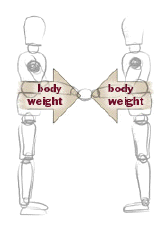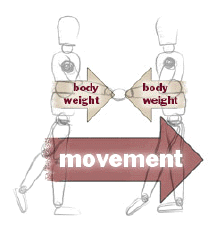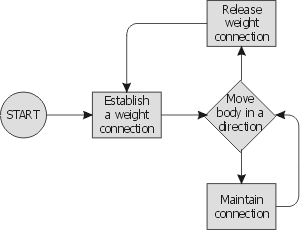Leading and Following in Open Positions
Leading Directional Movements
In a closed position dance hold, leading directional movement is a relatively simple process: Since the partners' bodies are directly connected, the leader simply moves in a direction, and
the follower should automatically respond with equal movement.
In open position, the mobility of the arms adds a layer of complexity and variability. But it can be simplified as long as (1) the arms remain still, and (2) before moving in a direction, you establish a weight connection, first.
 |
 |
Step 1: Connect body weight using a body weight connection -- either push or pull. |
Step 2: Move body weight in a direction. No physical pushing or pulling is necessary. |
The tension applied to a connection gives the leader a means by which he can communicate the direction of his movement. Once either push or pull has been established, the connection has been effectively "switched on", and the leading or following of directional movement can begin. With the tension in place, the leader does not need to do any additional pushing or pulling through the arms; He only needs to move his body in one direction or another. The follower will automatically feel and respond to his movement through the active connection.

As illustrated by this incredibly complicated looking flowchart, the connection is first established, and then the body moves. The connection can then be maintained or released. If the weight connection is released, another connection can be established in a new direction.
Push Backwards, Pull Forward
Push is most often used to lead the follower to step backwards, while pull is used to lead the follower forward.
In theory, any direction of movement can be led with either a push or a pull connection. There are many instances where you may wish to simply establish a connection such as push, and maintain it throughout a series of movements with many directional changes. Again, this is possible because once the connection is established, the follower can feel the leader's movement in any direction. But in general, we will be discussing push as a method of leading the follower to step backwards, and pull as a method of leading the follower forward.
Perspective: Leader
Your job as the leader is to clearly communicate your intentions. The best way to do this is to move your body from one foot to another, in a clear direction. The more you attempt to manipulate the follower's movement by pushing or pulling her with your hands and arms, the more superficial and less effective your lead becomes. In fact, it's best not to think of leading your partner at all. Instead, simply lead yourself. With the right connection, your partner will have no choice but to follow.
Perspective: Follower
Following is reaction. In order for a reaction to take place, there must first be an action. If you react before your partner acts, you're not really reacting at all... you're second-guessing. And unless you're a psychic, your predictions will not always pan out.
As the follower, your job is to produce an equal and opposite reaction. If the leader pushes, you push. If the leader pulls, you pull. If the leader moves, you move. Always respond to an action in kind.
But while this may seem logical enough, it's surprising how many followers don't quite get it right. The most common mistake is to react to the feeling of push by taking a back step, or to react to the feeling of pull by taking a forward step. Remember, the leader's invitation to push or pull is not an indication of where to move. It is merely an attempt to establish a weight connection toward or away from each other.
So when you feel the leader's weight shifting toward you, you should shift your weight towards him. Don't actually take a step. Before you can take a step, the following conditions must be met:
- 1. You've both shifted towards or away from each other, and you can clearly feel each other's body weight.
- 2. Through this weight connection, you actually feel him take a step.
To take a step before you establish the weight connection is to second-guess the leader's intentions, which you now know is ineffective and error-prone.



